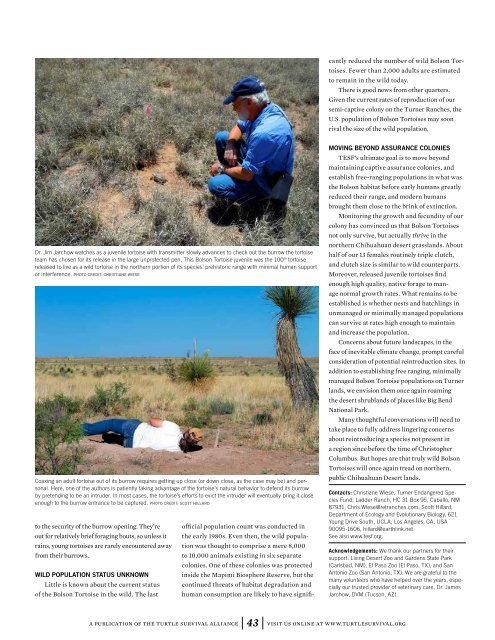Turtle Survival
2tUaeTbNi
2tUaeTbNi
You also want an ePaper? Increase the reach of your titles
YUMPU automatically turns print PDFs into web optimized ePapers that Google loves.
official population count was conducted in<br />
the early 1980s. Even then, the wild population<br />
was thought to comprise a mere 8,000<br />
to 10,000 animals existing in six separate<br />
colonies. One of these colonies was protected<br />
inside the Mapimi Biosphere Reserve, but the<br />
continued threats of habitat degradation and<br />
human consumption are likely to have significantly<br />
reduced the number of wild Bolson Tortoises.<br />
Fewer than 2,000 adults are estimated<br />
to remain in the wild today.<br />
There is good news from other quarters.<br />
Given the current rates of reproduction of our<br />
semi-captive colony on the Turner Ranches, the<br />
U.S. population of Bolson Tortoises may soon<br />
rival the size of the wild population.<br />
Dr. Jim Jarchow watches as a juvenile tortoise with transmitter slowly advances to check out the burrow the tortoise<br />
team has chosen for its release in the large unprotected pen. This Bolson Tortoise juvenile was the 100 th tortoise<br />
released to live as a wild tortoise in the northern portion of its species’ prehistoric range with minimal human support<br />
or interference. PHOTO CREDIT: CHRISTIANE WIESE<br />
Coaxing an adult tortoise out of its burrow requires getting up close (or down close, as the case may be) and personal.<br />
Here, one of the authors is patiently taking advantage of the tortoise’s natural behavior to defend its burrow<br />
by pretending to be an intruder. In most cases, the tortoise’s efforts to evict the intruder will eventually bring it close<br />
enough to the burrow entrance to be captured. PHOTO CREDIT: SCOTT HILLARD<br />
to the security of the burrow opening. They’re<br />
out for relatively brief foraging bouts, so unless it<br />
rains, young tortoises are rarely encountered away<br />
from their burrows.<br />
WILD POPULATION STATUS UNKNOWN<br />
Little is known about the current status<br />
of the Bolson Tortoise in the wild. The last<br />
MOVING BEYOND ASSURANCE COLONIES<br />
TESF’s ultimate goal is to move beyond<br />
maintaining captive assurance colonies, and<br />
establish free-ranging populations in what was<br />
the Bolson habitat before early humans greatly<br />
reduced their range, and modern humans<br />
brought them close to the brink of extinction.<br />
Monitoring the growth and fecundity of our<br />
colony has convinced us that Bolson Tortoises<br />
not only survive, but actually thrive in the<br />
northern Chihuahuan desert grasslands. About<br />
half of our 13 females routinely triple clutch,<br />
and clutch size is similar to wild counterparts.<br />
Moreover, released juvenile tortoises find<br />
enough high quality, native forage to manage<br />
normal growth rates. What remains to be<br />
established is whether nests and hatchlings in<br />
unmanaged or minimally managed populations<br />
can survive at rates high enough to maintain<br />
and increase the population.<br />
Concerns about future landscapes, in the<br />
face of inevitable climate change, prompt careful<br />
consideration of potential reintroduction sites. In<br />
addition to establishing free ranging, minimally<br />
managed Bolson Tortoise populations on Turner<br />
lands, we envision them once again roaming<br />
the desert shrublands of places like Big Bend<br />
National Park.<br />
Many thoughtful conversations will need to<br />
take place to fully address lingering concerns<br />
about reintroducing a species not present in<br />
a region since before the time of Christopher<br />
Columbus. But hopes are that truly wild Bolson<br />
Tortoises will once again tread on northern,<br />
public Chihuahuan Desert lands.<br />
Contacts: Christiane Wiese, Turner Endangered Species<br />
Fund, Ladder Ranch, HC 31 Box 95, Caballo, NM<br />
87931, Chris.Wiese@retranches.com; Scott Hillard,<br />
Department of Ecology and Evolutionary Biology, 621<br />
Young Drive South, UCLA, Los Angeles, CA, USA<br />
90095-1606, hillard@earthlink.net<br />
See also www.tesf.org.<br />
Acknowledgements: We thank our partners for their<br />
support: Living Desert Zoo and Gardens State Park<br />
(Carlsbad, NM), El Paso Zoo (El Paso, TX), and San<br />
Antonio Zoo (San Antonio, TX). We are grateful to the<br />
many volunteers who have helped over the years, especially<br />
our trusted provider of veterinary care, Dr. James<br />
Jarchow, DVM (Tucson, AZ).<br />
a publication of the turtle survival alliance 43 visit us online at www.turtlesurvival.org


